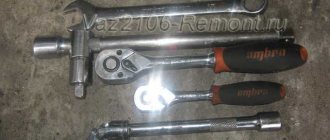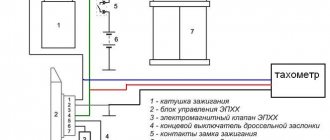The heating, ventilation and air conditioning system of the Vesta's interior differs from similar systems of other Lada models. The difference is not only in its design, but also in the control method. Let's look at the design features of the Vesta stove, and also evaluate its effectiveness.
The Lada Vesta car has a stove heater…
...designed to heat the car interior.
The stove is also actively used in rain or cold weather. The heater is also activated if necessary to quickly remove fogging from the windows or warm up passengers. In the “Lux” configuration, the car is additionally equipped with air conditioning, which creates a favorable temperature for a person.
The most common malfunctions of the Lada Vesta heater radiator: leakage, fan noise, engine vibration. The replacement process is not complicated, but requires care on the part of the repairman.
Cooling, heating (engine and air conditioning radiators) Lada Vesta
Products from the Dustershop77 range on the topic of the article:
| Name | Manufacturer | Price | Availability | Add to cart |
| DC1553-7701208363 | Set of sealing rings for air conditioner pipes (6 pcs) original 7701208363 | Original | 1100 / 900 rub. Discount: 700 rub. | 2 |
| DC1941-8450006450 | Expansion tank Vesta 8450006450 original | Original | 1000 / 900 rub. Discount: 700 rub. | 3 |
| DC1661-210102692R | Water pump (pump) engine 1.6 H4M original 210102692R / 210102248 | Original | 4100 / 3600 rub. Discount: 3300 rub. | 1 |
| DC1662-WPP2463 | Water pump (pump) engine 1.6 H4M PILENGA analogue 210102692R / 210102248 | Analogue | 1600 / 1200 rub. Discount: 990 rub. | 1 |
| DC1666-LWP0129 | Water pump (pump) 1.6 / 1.8 21129/21179 LUZAR analogue 21129130701020 / 21176130701000 | Analogue | 2000 / 1800 rub. Discount: 1700 rub. | 1 |
| DC1629-1040321ZH | Air conditioner radiator Logan 2014-, Vesta 2015- (Termal) | Analogue | 5500 / 4800 rub. Discount: 4300 rub. | 1 |
How the stove works on Lada Vesta. Device
- The heater radiator is connected to the system main via rubber pipes. The heat emitted by the internal combustion engine is transferred to the heating system.
- The heating system radiator distributes heat throughout the car interior using an electric fan.
- A preset resistor online regulates the fan rotation speed.
- The air flow is circulated and cleaned by a mesh and cabin filter (see diagram).
- With the help of installed dampers, the driver and passengers regulate the air flow flowing to them.
- The gearmotor rotates the damper based on the readings of the regulator and heater sensors.
Stove control
There have been no fundamental changes in the control of the air conditioning and ventilation system. Still, you may notice a few new keys.
Block "Classic"
Using buttons 11 to 16 you can adjust the direction of the air flow. Using the regulator number 9, the air temperature is controlled. 17 – air flow power.
"Comfort" block
Using key 18 you can turn on the air conditioning, 19 – air recirculation in the car interior. Control of parameters such as fan speed, temperature, air flow distribution is similar to the “Classic” version.
Block "Lux"
As for the “Lux” version, only two keys have been changed. 24 is now responsible for forcing the air conditioning on, as well as for heating the mirrors.
When you press key 20, you activate the automatic mode for selecting the air temperature in the cabin depending on the current temperature outside the cabin.
Typical stove malfunctions
The most common problems with the stove on Lada Vesta are the following:
- the actual temperature does not correspond to the set one - low level of antifreeze (antifreeze), clogged radiator pipes or the formation of an air lock, which causes cold air to blow;
- vibration appears during operation - the electric motor is loose;
- insufficient air flow from the deflectors - clogging of channels and air ducts;
- the heater is inactive when it is activated on the dashboard - failure of the fuse (No. 14) of the mounting block.
Checking the stove fan
During the circulation of the air flow, dust particles settle on the surface of the impeller, as a result of which it begins to make noise and extraneous sounds appear.
To clear the fan blades of debris, it is necessary to provide access to the unit.
- Unsnap the glove box.
- Remove the filter element.
- On the right is the furnace mechanism. We press the plastic clips and turn the impeller counterclockwise.
- We remove the motor.
- We wipe the drive with a rag.
- Install the parts in reverse order.
Checking the stove dampers
Dampers are installed in the area between the deflectors and the fan. During operation, they fail, become deformed, and become damaged. Checking the serviceability of the damper on your own is quite simple: you need to activate the stove at maximum speed. If it doesn't blow well, it means the air duct is clogged. Change the damper positions. If you hear squeaking or noise, lubricate the moving parts with silicone grease.
Foggy windows when the heater is activated is the first sign of a ventilation problem. This problem provokes a sharp decrease in visibility on the road and an increase in the risk of an emergency. As soon as fogging is detected, check the condition of the ventilation; most likely, the air ducts are clogged.
Checking heating efficiency
Carry out prevention before the onset of winter. Be sure to check:
- heating the air;
- changing speed modes when switching the control lever, if necessary, replace the brushes of the stove motor;
- absence of extraneous noise, whistling in fan operation;
- the need for a time interval to warm up the air ducts.
Note to the driver! The left and right pipes must be at the same temperature. Otherwise, this is a sign of a malfunction of the heating system.
How to solve the problem yourself
Over 10,000 km, dust accumulates on the fan blades; the thickness of this layer can be several millimeters. Also, pieces of debris (a twig, leaf, etc.) may get stuck between the blades. All this causes imbalance during rotation. Sometimes at speed 4 of the stove the vibration is so strong that it causes noise and is even transmitted to the steering wheel of the car. And the leaves in the impeller create an unbearable rustling and whistling sound.
The main task is to clean the heater fan from dust and dirt. To check vibrations, you can connect a motor from a battery. If necessary, to reduce vibrations, we rearrange the balancing weights to other blades.
It is also proposed to slightly modify the design (to reduce the vibrations transmitted by the fan) - stick an anti-creak (madeline) on the edges.
- Remove the top panel in the glove compartment.
- Remove the impeller from the housing (press the petal on top and turn the motor slightly counterclockwise).
- It is not possible to completely pull the motor out through this hole, so we clean it with a suitable tool (for example, a flat-head screwdriver) without removing the fan.
Method 2: Remove the cabin air filter and place a cloth at the front passenger's feet. Remove the frill from the passenger side and insert the air conditioner cleaner tube (the canister costs about 700 rubles) into the air intake. Turn on the stove and release the foam.
Replacing a stove radiator with your own hands on a Lada Vesta
Preparation of the workplace, necessary tools:
- rags;
- Phillips head screwdriver;
- flashlight to increase visibility;
- new radiator.
How to remove a radiator. Replacement sequence:
- We turn off the engine, turn off the ignition, and squeeze the parking brake.
- Open the hood and remove the terminal from the battery.
- We grind off the antifreeze from the system. The plug is located at the bottom point of the radiator (key 17).
- We remove the decorative trim on the instrument panel.
- Remove the top decorative trim above the glove box. Let's take it out.
- We dismantle the metal dashboard support on the driver's side.
- Remove the air pipe.
- Open the stove lid.
- We remove the heater.
- We install a new heater radiator.
- We assemble the structure in reverse order.
Standard heater radiator
The heater radiator is the same in design as the radiator of the Lada cooling system, only smaller. They have a common antifreeze range. Dirt from the expansion tank may also end up in the small interior assembly. Unfortunately, the radiator cannot be repaired. Need a replacement. When we come closer to the question, it turns out that the standard unit does not have a serial number. There is only a code - UT-00006936, according to which they can sell you another spare part. Therefore, before purchasing, check with the seller for information.
Review of Manufacturer Prices
Dimensions: 184x133.5x26 mm.
| Serial number/item | Price in rubles |
| LUZAR 271153553R (original) | From 5000 |
| STELLOX 10-35126-SX | From 4500 – 4700 |
| FENOX RO0004C3 | From 4500 – 4700 |
| RO0003O7 | From 4500 – 4700 |
| AVA QUALITY COOLING RTA6398 | From 4500 – 4700 |
| VALEO 812374 | From 4500 – 4700 |
| NISSENS 76512 | From 4500 – 4700 |
| MAGNETI MARELLI 350218221003 | From 4500 – 4700 |
| *prices are as of May 2021 | |
CHECKING THE OVEN FAN
Use the fan speed control knob to alternately switch four speeds. We check how it blows from the air ducts as the fan speed increases.
- If the stove does not work (the fan does not rotate at all), check the fuse in the mounting block (F45).
- If only one or more fan speeds do not work, then the cause may be a faulty auxiliary resistor or vehicle wiring.
- If the stove blows poorly (the air flow intensity is low), it means that the air intake grille or the cabin air filter is clogged.
We advise you to read our articles
What is the main problem with Lada XRAY?
How Lada XRAY will feel in five years or 100 thousand kilometers
Lada Xray with ESP disabled: video test drive
How to remove the generator on Lada X Rey
Reviews
| № | Positive |
| 1 | Andrey (Avtodrom): I’m happy with the heater’s performance, it’s warm in winter, and there’s good air flow in summer. |
| 2 | Sergey (Avtotema): unlike the Lada Grant, the stove on the Lada Vesta is improved, modified, that’s enough for me. |
| 3 | Kirill (Autoreview): in severe frosts, the heater takes a long time to warm up, but then the heat output is maximum. |
| 4 | Alexey (Avtoria): in the third year of operation, I replaced the antifreeze in the system, it suddenly darkened, and a sediment appeared. Comrades say that the quality does not match. |
| 5 | Alexander (Drom): I regularly carry out a technical inspection of the car, there are no problems with the heater. |
| 6 | Stanislav (Driving): my positive review of the Lada Vesta stove, finally the engineers have eliminated the shortcomings and improved the air supply mechanism. |
| 7 | Vasily Alekseevich (“5th wheel”): for five years of using the car, I have not contacted a service station for stove repair. |
| Negative | |
| 8 | Vitaly (Avtotema): in winter, in severe frosts, it does not heat well, there is insufficient airflow from the left deflector. |
| 9 | Svyatoslav (Otzovik.net): The heater motor failed at 40,000 km, fortunately the car is under warranty, it was replaced free of charge. |
| 10 | Vlad (ProAvto): the stove is just like a stove, I can’t say anything special. It seems to me that in Renault Logan the blowing mechanism is implemented better. |
Reviews about the Vesta stove
The first reviews from Vesta owners about the stove are generally positive. No significant deficiencies were identified. The car warms up quickly. It blows quite strongly from all the air duct nozzles. In cold weather at -25 degrees, the car interior is warm and comfortable. When using the control unit and adjusting the deflectors, the cost of the parts is not visible; in terms of quality, it resembles a foreign car.
To improve the efficiency of the heater, close the glove compartment cooling in winter:
Let us remind you that with the first cold snap we were also able to test the operation of the heating. You can find other information about Vesta that interests you in this content. By the way, problems with the operation of the stove can be caused by an air lock in the cooling system.
How does your Vesta’s stove heat? In the comments to the article we leave impressions and notes about the efficiency of the heater.
Categories of products that you may be interested in based on the article “Stove (heater) Lada Vesta, device and reviews”:
DIAGRAM OF CLIMATE INSTALLATION LADA VESTA/XRAY
Air conditioning system Lada Vesta/XRAY: 1, 2, 5 — air conditioning system pipelines; 3 — air conditioning compressor drive belt; 4, 15 — hoses of the engine cooling system; 6 - engine; 7 — air conditioning filter; 8 — air conditioner electric fan; 9 — air conditioner evaporator; 10 — air conditioner housing; 11 — radiator of the heating system; 12 — heater radiator supply hose; 13 — heater radiator outlet hose; 14 — air conditioning compressor; 16 — fan of the engine cooling system; 17 — radiator of the cooling system; 18 - air conditioner condenser.
Checking the stove fan
The Vesta cabin filter is located above the blades of the unit. The job of the filter element is to collect dust and debris coming from the street. It is possible that these particles may penetrate into the ventilation device. Leaves or pebbles begin to rotate inside the impeller - the fan makes noise.
- To clean it, you need to make access to it free;
- To do this, remove the glove compartment and take out the filter element;
- Now, on the right side of the furnace body we find the mechanism. We clamp the petal located at the top, turn the impeller counterclockwise, and remove the motor;
- We clean the engine with napkins and cotton swabs. One of the reasons for the slowly working mechanism is a dense layer of dust on the walls;
- We install the unit in place and assemble the interior plastic.
If the Lada fan does not blow at all, the cause may be a blown fuse. Then you don’t need to disassemble anything, just replace the circuit element in the fuse control unit.
About the stove
Many drivers who switched to Vesta from Kalin or Prior note that in older cars the interior warms up faster. The stove in them is warmer, heats better, I also agree with this.
Before this, I also drove a Kalina, it will have a bigger stove. In the Lada Vesta I am also satisfied with the heater, but it does not have a certain reserve. It feels like the stove is working at its limit, and there is no way to somehow make it hotter or heat the interior more.
I decided to figure out what this was connected with. I went to an auto parts store and asked to look at the heater radiators of Vesta and Kalina. I was very surprised. The Vestovsky radiator is much smaller than the Kalinovsky one - in area, size, weight.
It looks like a toy. The Kalinovsky stove radiator inspires much more confidence.
Of course, size is not the most important thing in a radiator.
It is important what and how it is made, the surface area from which heat is taken, and the number of fins. But, if you look visually, Kalinovsky inspires much more confidence
Its efficiency is higher, and it will warm up the interior better.
Plus, the interior of the Lada Vesta is larger, more spacious, and there is a lot of air that needs to be warmed up. In Kalina, the interior is smaller. It turns out that the smaller Lada Kalina or Priora has a larger heater radiator. But in Vesta, on the contrary, it is less.
Interior ventilation diagram
Air ducts run from the stove body, which direct air flows to the windows, into the interior and legs. The central deflectors can adjust air flow in different directions, and its strength is controlled using a horizontal wheel underneath them.
AvtoVAZ has implemented airflow for the Vesta driver’s feet in a new way. The air duct nozzle is located not on the side, but above the foot of the right foot. Some owners of the new sedan believe that this design is not very successful, because It warms the toes worse than the foot itself. For the front passenger, the air duct exits closer to the wall of the engine shield and a similar situation will not arise.
Worth o. On versions of the car with air conditioning, a small air duct fits into the glove compartment, which can cool, for example, a water bottle.
WHY DO GLASSES FOG?
The car windows should not fog up while the heater is operating If this happens, then the cause may be:
- heater core leaking
- cabin filter is clogged
- The electric recirculation air damper actuator is faulty
No matter what AVTOVAZ PR people say, the LADA Vesta, in accordance with the traditions of the Soviet automobile industry of the last century, turned out to be a “crude” car - with a lot of design flaws and quality defects. One of the global “jambs” that causes a lot of complaints - the clutch and manual gearbox - AVTOVAZ has already begun to change it to “more different ones”. It is not yet known whether this step will remove the claims of car owners about their reliability and smooth operation. It’s good that the company, although a year late, is trying to make its car better.
The heating, ventilation and air conditioning system of the Vesta's interior differs from similar systems of other Lada models. The difference is not only in its design, but also in the control method. Let's look at the design features of the Vesta stove, and also evaluate its effectiveness.











